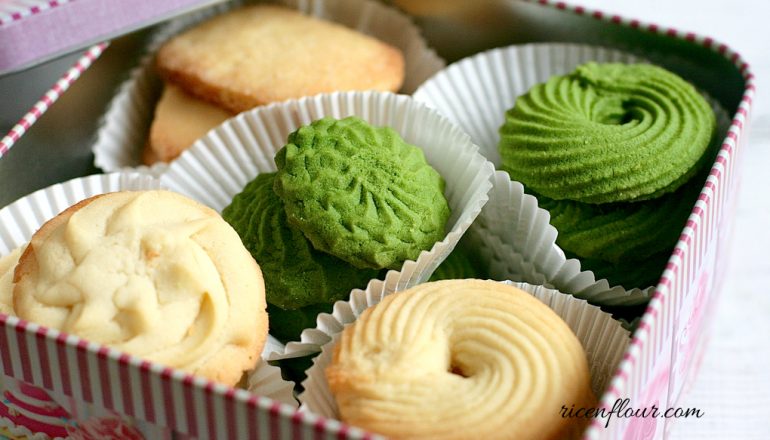Danish butter cookies in Royal Dansk blue tin have been so popular as seasonal gifts for Christmas and New Year. Crispy, delicious and full-of-butter-taste, they are especially enjoyed in teatime and as snacks. In Denmark, the cookies are traditionally served, along with rice pudding as desserts at Christmas, in various shapes and various names (yes they have their own names!) including finsk brød (Finnish bread), vanille kranse (vanilla wreaths), kringle (Danish pretzels), kanelkager (cinnamon cakes). Interesting enough for those little bite-sized cookies?
It also turns out, surprisingly, that making traditional Danish butter cookies is nothing difficult since normally Danish butter cookies are made from butter (the very famous Lurpak butter of Danes), flour and sugar. These simple ingredients of the finest quality are mixed together into soft and sticky dough before being shaped with the help of piping bag. I even prefer these home-made cookies as they’re as delicious as the mass-production ones while giving my kitchen the seasonal atmosphere that we feel every time the Christmas and New Year are approaching.
DANISH BUTTER COOKIES RECIPE
Yield: 25 – 30 cookies depending on size
INGREDIENTS:
- 113 gram unsalted butter – very soft but not melted
- 1 egg white (30 – 33 gram) – at room temperature
- 65 gram icing sugar
- 4 ml (3/4 tsp) vanilla extract
- 155 gram all-purpose flour
* Notes:
1. It’s recommended to use butter. But feel free to substitute by vegetable butter or margarine if you prefer. Since the quality of butter will define the taste of cookies, you should use the best one at hands.
2. Measure the egg white carefully. Too much egg white (more than 35 gram) will result in firm and hard cookies.
3. Don’t substitute icing sugar by granulated sugar because it may not dissolve completely in the dough, thus resulting in dough that is too wet or cookies with a lot of tiny holes on the surface.
4. If vanilla extract is not available, vanilla bean can be used. Split the vanilla bean down its length and scrape the seeds to use. Don’t use artificial vanilla flavour since the cookies may have bitter taste.
5. Use all-purpose flour (10.5% – 11% protein). Bread flour with higher protein content will give hard and dry cookies while flour with lower protein content (cake flour) will make the cookies a bit too crumbly.
INSTRUCTIONS
A detailed recipe with all the specific notes is available on my YouTube Channel (Savoury Days Kitchen) in both English and Vietnamese (select your preferred language by clicking CC > Setting > Language). You guys can check it out at this link or the video right below.
* Printable recipe
1. Lightly cream the butter by a spoon to make it soft. Add egg white and sift icing sugar into the bowl. Mix until just incorporated.
2. Sift flour into another bowl. Add half of the flour to the butter mixture and mix until incorporated. Then add the remaining half of flour and mix well. The dough can be mixed by hands until incorporated. Don’t overmix!
3. Preheat the oven to 200 °C (400 °F) (top and bottom heat). Prepare a baking pan lined with parchment paper. Notes: Don’t use the black baking pan of the oven since their high heat-transferring ability (when directly touching the oven’s walls) may easily burn the cookies.
4. Add the dough to a piping bag, cut the tip and put it in another piping bag. The dough is quite thick so it’s better to have two layers of piping bag to avoid breaking the bag while piping. You may want to use Wilton 1M, 2D tips or the star-shaped one as in the video.
5. Pipe the dough onto the baking pan.
6. Bake the cookies on middle rack at 200 °C (400 °F) in 5 minutes, then set the oven temperature to 175 °C (350 °F) and bake for 5 – 7 minutes more until the cookies’ edges turn golden brown. Baking temperature and time may vary depending on the ovens and the sizes of cookies. Smaller cookies may have shorter baking time.
7. Take the cookies out of the oven and let them cool down completely on the baking pan (don’t move the cookies when they’re still warm since they may break). The cookies should be kept in an airtight container preferably with desiccant bag. Use within 3 weeks.
The cookies should have delicious taste of butter and vanilla and moderate hardness and crunchiness without being crumbly.
* Troubleshooting common problems
– If the cookies are crumbly and easily broken, the reasons can be from using flour of high hydration level, or baking for too long. It’s recommended to use a little less flour or decrease baking time.
– If the cookies are too dry or too flour-y, you should increase the amount of butter by 10 – 15 gram since the flour you use may have high hydration level.
– If the cookies get softened, it’s recommended to bake them for 5 minutes while the oven is preheating at 100 – 110 °C (210 – 230 °F). Don’t bake for too long since they will get even drier and more crumbly.
– If the cookies’ edges get burnt too quickly, check the oven temperature; the actual oven temperature can be higher than the temperature you set, especially in small ovens. Hence, it’s better to use oven thermometer.
* Notes:
1. Feel free to add other tastes to the recipes. For example, substitute 5 gram flour by 5 gram of green tea powder (matcha) to make matcha cookies. Or substitute 10 – 15 gram flour by the same amount of cocoa powder to make chocolate cookies. Since cocoa powder absorbs more water than flour, you should decrease the amount of flour or increase the amount of butter.
2. Apart from using piping tip and bag to shape the cookies, you can roll the dough and use cookies cutter (see more instructions in “How to make Sakura Flower cookies recipe”), or cookies press, or simply roll the dough into cylinder shape and slice. If the dough is too sticky, it’s recommended to put it in the fridge in 30 minutes until the butter hardens and the dough is less sticky.
- Recipe by: Linh Trang
- Written by: Xuan Tran




these are beautiful, I’m on such a piped butter cookie kick right now, I’m really tempted to try your recipe.